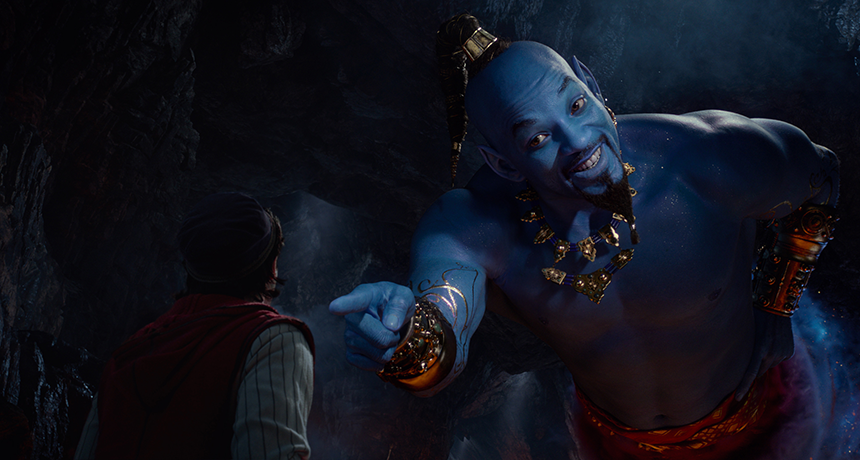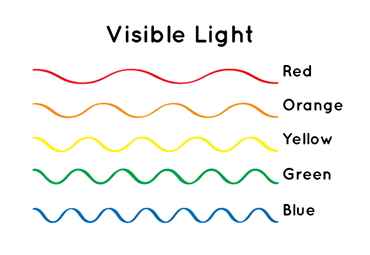Let’s turn a genie blue
Here’s how nature could explain the bright blue hue of the one in Aladdin

Aladdin’s genie takes the shape of a giant blue man. But why is he blue in the first place?
Courtesy of Disney
In the magical world of Disney’s Aladdin, carpets fly, princesses have pet tigers and a pauper can become a prince with the help of a genie. The original cartoon and the new live-action film bring up a lot of questions, but one in particular stands out: Why is that genie blue?
While magical genies don’t exist, there are plenty of ways that nature can bring someone the blues.
The color people perceive as blue is a trick of the light, explains Richard Prum. He’s an ornithologist — someone who studies birds — at Yale University in New Haven, Conn. “To me, the genie is blue because the genie is substanceless,” Prum explains. “It’s the same reason the sky is blue.”

The sky is blue because of the way light scatters. Light travels in waves. We perceive different wavelengths of light as different colors. Red, for example, has long, stretched out waves. Blue’s waves are short and choppy. (This electromagnetic spectrum extends out to even longer and shorter wavelengths that we can’t see at all.)
Light from the sun consists of many wavelengths. Combined, they appear white. When that light encounters Earth’s atmosphere, it hits gas molecules. This causes the light waves to scatter in different directions. Some, such as blue, scatter more. Long wavelengths, such as red, scatter less. The result is that to us the sky looks blue.
If the genie were a gassy giant, Prum explains, the molecules in that gas would scatter short wavelengths of light and make the genie appear blue.
Bringing on the blues
But there’s more than one way to scatter light and make blue. Many real creatures flaunt blue hues in their skin. Blue-footed boobies have — you guessed it — blue feet. Other birds have blue necks or blue beaks. Mandrills — a species of monkey — have bright blue faces, while male vervet monkeys have bright blue private parts.
Walt Disney Studios/YouTube
Prum has looked into how birds produce blue colors in their skins. He conducts this work with Rodolfo Torres, a mathematician at the University of Kansas in Lawrence. The pair carefully examined 31 bird species. All, they found, produce their blue skin the same way.
In their skin, these birds have long strands of collagen. It’s a fibrous molecule usually found in bones and tendons. Their skin’s collagen lies in a ring structure on top of a layer of melanin — a dark pigment. When light enters the skin, Prum explains, it scatters off one fiber and then a neighboring fiber and then off all the other fibers before that light finally gets reflected onto your eye. Because the collagen fibers break up the wavelengths of every color except blue, you perceive that light — and the bird’s skin — as blue.
Prum and Torres published their findings many years ago in the Journal of Experimental Biology.
Blue people
The collagen in human skin isn’t arrayed in the right way to give us a Smurf-like hue. But with the right metals, people can turn blue, too. A condition called argyria can develop when someone is exposed to too much silver. “It’s not totally blue, like the genie. It’s more of a silver-blue,” says Bettina Heidecker. She’s a cardiologist, someone who treats diseases of the heart, at Charité University Clinic Berlin in Germany.
A few years ago, Heidecker treated a patient who came in with bluish skin and fingernails. He got that blue tinge in part because he had been following doctor’s orders, she says. Doctors sometimes prescribe creams containing silver for people who have wounds that fail to heal. Silver kills bacteria, she explains, so silver-containing creams can help fight infections.
But when the man’s wounds still didn’t heal, the patient started taking some pills that contained silver. He’d ordered them off the internet. “He took them every day over years,” Heidecker says. In time, the silver from the pills collected in the man’s skin. When that hue combines with the skin’s natural pinkish tint from the blood vessels inside, a person’s skin can appear blue.
Heidecker looked at a sample of the man’s skin under a microscope and saw deposits of silver everywhere she looked. And that color is permanent, she notes. “There’s no way to get it out again.” Luckily, it’s just a color and not something worse. But she cautions against ordering pills online, especially when the drugs are not approved and it’s not clear what is in them. Heidecker and her colleagues published their analysis of the patient in 2017 in the American Journal of Medicine.
If she had to make a genie blue, Heidecker say, argyria is how she’d do it. “Maybe going in and out of the bottle all the time, he got some wounds on his chest,” she says. “He might need a skin cream, and silver is very helpful.”
If you’re a genie that’s lived for thousands of years, a few hundred years of silver skin cream might just be enough to give you the blues.







